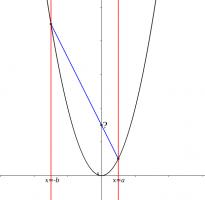Puzzles
23 December
I draw the parabola \(y=x^2\) and mark points on the parabola at \(x=17\) and \(x=-6\).
I then draw a straight line connecting these two points.
At which value of \(y\) does this line intercept the \(y\)-axis?
6 December
\(p(x)\) is a quadratic with real coefficients. For all real numbers \(x\),
$$x^2+4x+14\leq p(x)\leq 2x^2+8x+18$$
\(p(2)=34\). What is \(p(6)\)?
Between quadratics
Source: Luciano Rila (@DrTrapezio)
\(p(x)\) is a quadratic polynomial with real coefficients. For all real numbers \(x\),
$$x^2-2x+2\leq p(x)\leq 2x^2-4x+3$$
\(p(11)=181\). Find \(p(16)\).
Parabola
Source: Alex Through the Looking-Glass: How Life Reflects Numbers and Numbers Reflect Life by Alex Bellos
On a graph of \(y=x^2\), two lines are drawn at \(x=a\) and \(x=-b\) (for \(a,b>0\). The points where these lines intersect the parabola are connected.
What is the y-coordinate of the point where this line intersects the y-axis?



